Related Research Articles

Olympia is the capital city of the U.S. state of Washington and the county seat of Thurston County. It had a population of 55,605 at the time of the 2020 census, making it the state of Washington's 23rd-most populous city. Olympia borders Lacey to the east and Tumwater to the south.

Thurston County is a county located in the U.S. state of Washington. As of the 2020 census, its population was 294,793. The county seat and largest city is Olympia, the state capital.
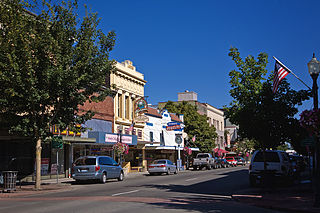
Centralia is a city in Lewis County, Washington, United States. It is located along Interstate 5 near the midpoint between Seattle and Portland, Oregon. The city had a population of 18,183 at the 2020 census. Centralia is twinned with Chehalis, located to the south near the confluence of the Chehalis and Newaukum rivers.
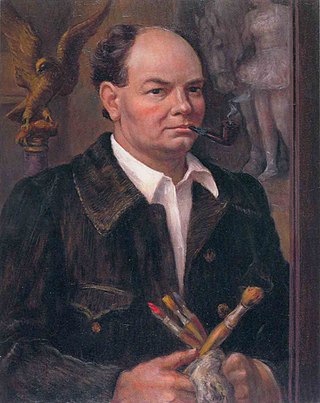
John Steuart Curry was an American painter whose career spanned the years from 1924 until his death. He was noted for his paintings depicting rural life in his home state, Kansas. Along with Thomas Hart Benton and Grant Wood, he was hailed as one of the three great painters of American Regionalism of the first half of the twentieth century. Curry's artistic production was varied, including paintings, book illustrations, prints, and posters.
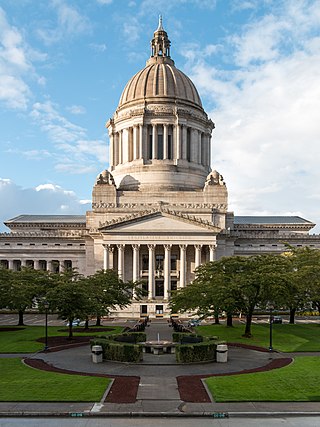
The Washington State Capitol in Olympia is the home of the government of the State of Washington. It contains the chambers of the Washington State Legislature, offices for the governor, lieutenant governor, secretary of state, and state treasurer. It is part of a larger administrative campus including buildings for the Washington Supreme Court, the Washington Governor's Mansion, and many other state agencies.

"Washington, My Home" is the state song of Washington, in the United States. It was composed in 1951 by Helen Davis and set to music by Stuart Churchill under the name "America, My Home". Subsequently, retitled and rewritten as "Washington, My Home", it was made the state song in 1959 by an act of the Washington State Legislature. An earlier anthem, "Washington Beloved", was declared the state song in 1909 by a ceremonial resolution of the state legislature.

The Alabama State Capitol, listed on the National Register of Historic Places as the First Confederate Capitol, is the state capitol building for Alabama. Located on Capitol Hill, originally Goat Hill, in Montgomery, it was declared a National Historic Landmark on December 19, 1960. Unlike every other state capitol, the Alabama Legislature does not meet there, but at the Alabama State House. The Capitol has the governor's office and otherwise functions as a museum.
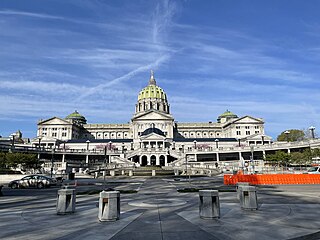
The Pennsylvania State Capitol is the seat of government for the U.S. state of Pennsylvania located in downtown Harrisburg. The building was designed by architect Joseph Miller Huston in 1902 and completed in 1906 in a Beaux-Arts style with decorative Renaissance themes throughout. The capitol houses the legislative chambers for the Pennsylvania General Assembly, made up of the House of Representatives and the Senate, and the Harrisburg chambers for the Supreme and Superior Courts of Pennsylvania, as well as the offices of the Governor and the Lieutenant Governor. It is also the main building of the Pennsylvania State Capitol Complex.

The Mississippi State Capitol or the “New Capitol,” has been the seat of the state’s government since it succeeded the old Mississippi State House in 1903. Located in the centrally-located state capital / capital city of Jackson, in Hinds County, it was designated as a Mississippi Landmark in 1986, abd subsequently a National Historic Landmark in 2016 and earlier added to the National Register of Historic Places in 1969,.
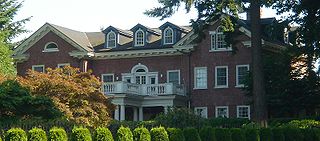
The Washington Governor's Mansion is the official residence of the governor of Washington. The Georgian-style mansion is located on the grounds of the State Capitol campus in the capital city Olympia. It is on the crest of Capitol Point, with a view of mountains, Capitol Lake and the city.

Centralia College is a public community college in Centralia, Washington. Although it primarily offers certificates and Associate degrees, it also offers a few Bachelor's degrees. Founded in 1925, Centralia is the oldest continuously operating community college in the state of Washington. The college sits on 29 acres (120,000 m2) in the middle of the town of Centralia. There is a branch education center, Centralia College East, in the town of Morton and the college offers a range of online and correspondence courses. Overall, the college serves an area of 2,409 square miles (6,240 km2) in Lewis County and southern Thurston County under the administrative classification of Community College District Twelve.

Alonzo Victor Lewis (1886–1946) was an American artist. He is primarily known for public sculptures in the State of Washington; he also painted in the Impressionist style.
Joseph Henry Wohleb (1887–1958) was an American architect from Washington.
Alden Lee Mason, né Carlson was an American painter from Washington known for creating abstract and figurative artwork. Mason was a professor of art at the University of Washington for over 30 years. His painting are held in a number of public collections including the San Francisco Museum of Modern Art, the Seattle Art Museum, the Portland Art Museum, and the Milwaukee Art Museum.

The Joel M. Pritchard Building at the Washington State Capitol campus in Olympia was built in 1957–1958 to house the Washington State Library, which had outgrown its previous location in the basement of the Washington Supreme Court's Temple of Justice. The building's architect, Paul Thiry who also designed the Century 21 Exposition complex in Seattle, used Modern design incorporating the Wilkeson sandstone quarried a few tens of miles away and used in the state capitol and other buildings. It was the last monumental building added to the capitol campus and one of the few departures from the Olmsted Brothers' 1928 campus plan. It was described as "among the most important regional archetypes of mid-century architectural design and thought...a textbook on how Washingtonians looked at the future in the 1950s". It was named for Joel M. Pritchard, a U.S. Congressman from Washington and the state's Lieutenant Governor. Thiry won the American Institute of Architects/American Library Association Library Building Award for the design, the first such award to be presented. The building was listed on the National Register of Historic Places in 2015.
The Washington State Library is a government agency that operates public libraries in Washington state's prisons and mental hospitals, and maintains collections related to the state government. Based in Tumwater, it is a service of the Washington Secretary of State and was founded in 1853 as the Washington Territorial Library. The library has a collection of 2.25 million physical items and other online resources available to residents of the state.

Jean Cory Beall ( was an American artist known for her large scale murals.
Michael Charles Spafford was an American artist known for his archetypal, figurative oil paintings drawn from Classical mythology. Spafford taught painting at the University of Washington, Seattle until his retirement in 1994.
References
- 1 2 "Photos of Spafford murals removal from house". official website. Washington Secretary of State. June 8, 2015. Retrieved May 19, 2020.
- ↑ Jeffrey L. Cruikshank; Pam Korza (1988). Going Public: A Field Guide to Developments in Art in Public Places. Arts Extension Service, University of Massachusetts Amherst. p. 128. ISBN 0945464002.
- 1 2 Associated Press (2003-08-30). "Controversial murals go to Centralia College". Seattle Post-Intelligencer. Hearst Seattle Media. Retrieved 2009-03-28.
- 1 2 Susan G. Hauser (July 31, 1987), "Pols vs. Hercules in Olympia", The Wall Street Journal , p. 1
- 1 2 3 Mather, Frank Jewett; Sherman, Frederic Fairchild (1988), Art in America , vol. 76, F.F. Sherman, p. 176
- 1 2 Kammen, Michael (2009). Visual Shock: A History of Art Controversies in American Culture. Knopf Doubleday. p. 146. ISBN 978-0307548771.
- 1 2 Farr, Sheilla (2001-06-08). "Exiled murals may surface in Centralia". The Seattle Times. The Seattle Times Company. Retrieved 2009-03-28.
- ↑ Alan Stein (March 5, 2013), "Washington House of Representatives votes to cover up controversial murals in House Chamber on March 7, 1982.", HistoryLink , Seattle: History Ink
- ↑ Debra Cassens Moss (February 1, 1988), "Mural, mural on the wall", ABA Journal , American Bar Association, p. 18
- ↑ DuBoff, L.D. (1977). The Deskbook of Art Law. Federal Publications. ISBN 9780317013269.
- ↑ "Columbia-VLA Journal of Law & the Arts". Columbia Law School. 1991. pp. 46–47. Archived from the original on 2023-05-12. Retrieved 2023-05-12.
- ↑ Camille Coonrod (2014). "Artist biography: Michael Spafford". Seattle Art Museum . Retrieved May 19, 2020.
- 1 2 Thomas, Ralph (2003-09-03). "Controversial murals on the move". The Seattle Times. The Seattle Times Company. Retrieved 2009-03-28.
- ↑ Washington State Dismantles Mural, Associated Press, December 10, 1987, p. C-17 – via The New York Times Archives
- ↑ "Academic libraries (Centralia College special collections)" (PDF), 2009 Directory of Washington Libraries, Washington State Library, 2009, p. 4
- 1 2 3 4 5 6 7 8 9 10 11 12 13 Tate, Casandra (14 December 2013). "Museum of Northwest Art (MONA) Michael Spafford Biography". monamuseum.org. Retrieved 9 June 2020.
- 1 2 Karlstrom, Paul (2–4 September 1992). "oral history interview with Michael Spafford and Elizabeth Sandvig". Archives of American Art. Smithsonian Institution (aaa.si.edu). Retrieved 13 November 2013.